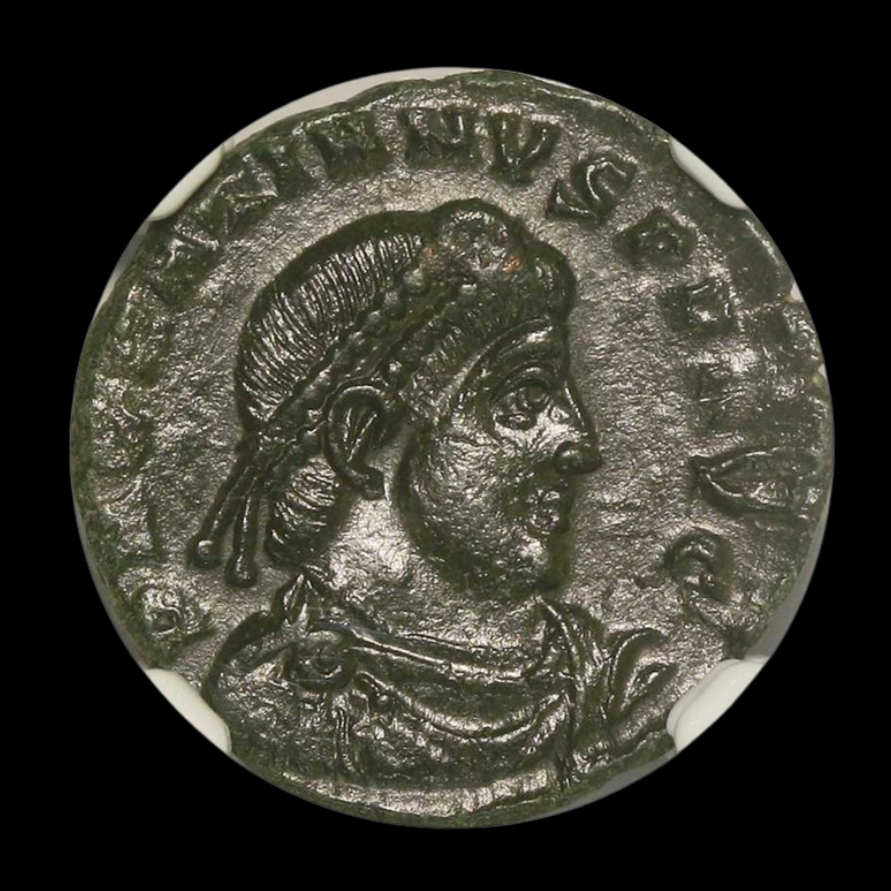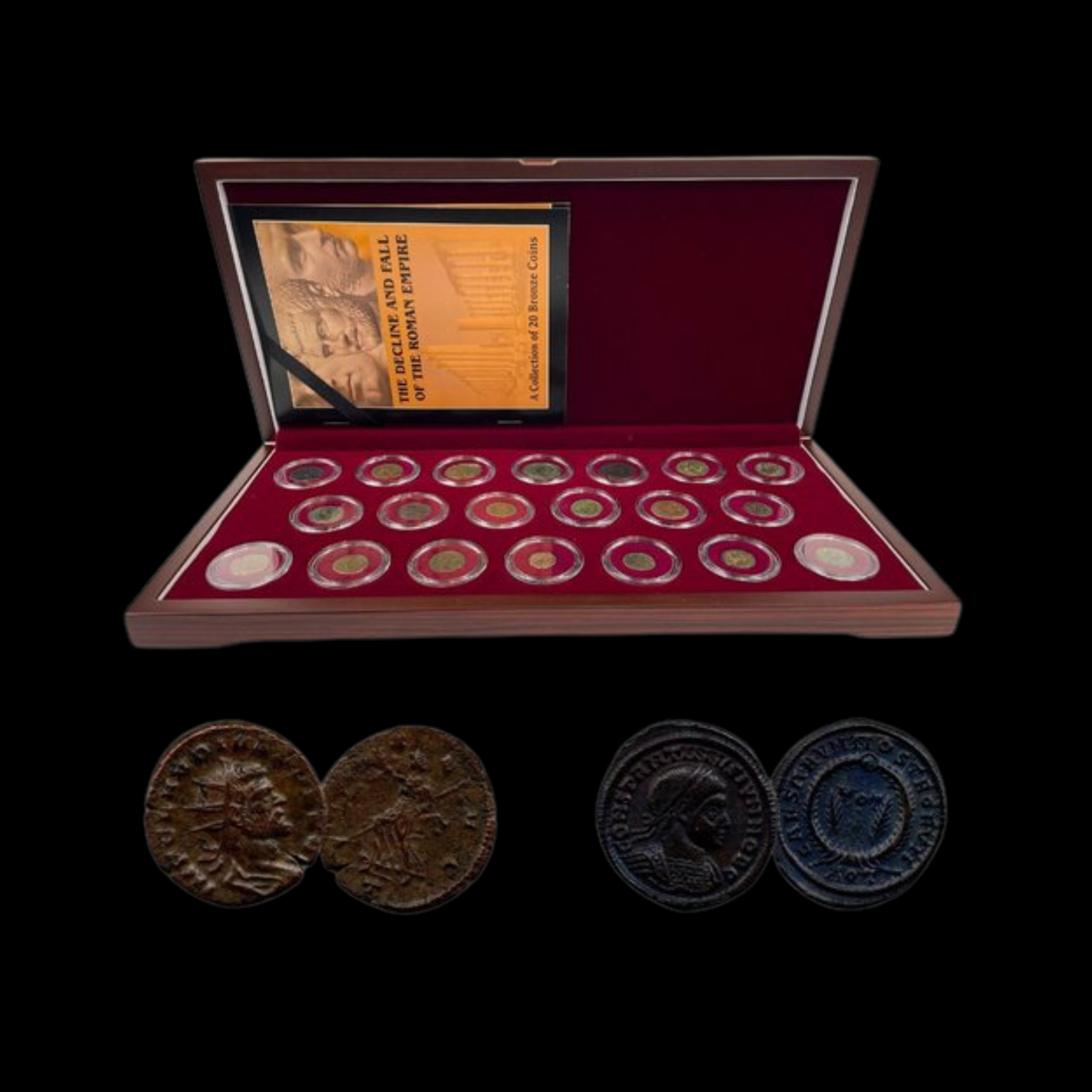 Image 1 of 2
Image 1 of 2

 Image 2 of 2
Image 2 of 2



Rome's Three Julias: Severan Dynasty Six-Coin Collection
This exceptional collection features six authentic Roman coins connected to the remarkable women of the Severan Dynasty who wielded extraordinary influence during the late 2nd and early 3rd centuries AD. These powerful "Three Julias" - Julia Domna, her sister Julia Maesa, and Julia Maesa's daughter Julia Mamaea - were instrumental in placing and maintaining their male relatives on the imperial throne.
1. Septimius Severus & Julia Domna Denarius (about 1825 years ago)
This silver coin features the founder of the Severan Dynasty alongside his influential wife Julia Domna, who became one of Rome's most powerful empresses.
Coin Description:
Front side: Portrait of Septimius Severus with laureate crown and beard, surrounded by his imperial titles
Back side: Portrait of Julia Domna with her characteristic wavy hair arranged in the "helmet" style, with inscription "IVLIA AVGVSTA"
Technical Details:
Silver composition
Denomination: Denarius
Date: 193-211 AD
Historical Significance: This coin represents the beginning of the Severan Dynasty. Septimius Severus, born in North Africa, seized power after the Year of the Five Emperors (193 AD) and established a new dynasty. His wife Julia Domna, from a prestigious Syrian priestly family, was celebrated on coinage as "Julia Augusta" and served as a key political advisor. She established a salon of philosophers and intellectuals, elevating the cultural status of the imperial court.
2. Julia Domna Denarius (about 1815 years ago)
This silver coin prominently features Julia Domna, who maintained significant influence even after her husband's death.
Coin Description:
Front side: Portrait of Julia Domna with her distinctive wavy hair arranged in a "helmet" style, with the inscription "IVLIA PIA FELIX AVG"
Back side: Likely depicts a goddess such as Venus, Ceres, or Vesta, or personifications like Pietas (Piety) or Pudicitia (Modesty)
Technical Details:
Silver composition
Denomination: Denarius
Date: 211-217 AD (from after Septimius Severus's death)
Historical Significance: This coin was minted when Julia Domna served as imperial advisor to her son Caracalla after Septimius Severus's death. Styled as "Julia Pia Felix Augusta" (Pious and Fortunate), she was the first to receive the title "Mater Castrorum" (Mother of the Camp), reflecting her influence over military affairs. Despite family tragedy—her younger son Geta was murdered by Caracalla—she maintained her political position until her death in 217 AD.
3. Caracalla Denarius (about 1810 years ago)
This silver coin depicts Caracalla, son of Septimius Severus and Julia Domna, known for his ferocity and for extending Roman citizenship to all free men in the empire.
Coin Description:
Front side: Portrait of Caracalla with short beard and laureate or radiate crown, with imperial titles
Back side: Possibly depicts military themes, victory symbolism, or deities like Sol or Serapis (whom Caracalla favored)
Technical Details:
Silver composition
Denomination: Denarius
Date: 211-217 AD
Historical Significance: Caracalla ruled as emperor after eliminating his brother Geta in 211 AD. Despite his reputation for cruelty, his reign saw the issuance of the Constitutio Antoniniana in 212 AD, which granted Roman citizenship to all free men throughout the empire—one of the most significant edicts in Roman history. His assassination in 217 AD marked the beginning of a new period of instability until his distant cousin Elagabalus came to power through the machinations of Julia Maesa.
4. Julia Maesa Denarius (about 1800 years ago)
This silver coin features Julia Maesa, sister of Julia Domna, who orchestrated the rise of both her grandsons to imperial power after Caracalla's assassination.
Coin Description:
Front side: Portrait of Julia Maesa with elegant hairstyle similar to her sister's, with the inscription "IVLIA MAESA AVGVSTA"
Back side: Likely depicts Pudicitia (modesty), Pietas (piety), or Fecunditas (fertility), reflecting traditional Roman feminine virtues
Technical Details:
Silver composition
Denomination: Denarius
Date: 218-225 AD
Historical Significance: After Caracalla's assassination, Julia Maesa used her enormous wealth and political acumen to place her grandson Elagabalus on the throne, claiming he was Caracalla's illegitimate son. When Elagabalus's eccentric religious practices and behavior threatened the dynasty, she orchestrated his replacement with her other grandson, Severus Alexander. Her political genius ensured the Severan dynasty's continuation despite multiple crises.
5. Elagabalus Denarius (about 1800 years ago)
This silver coin depicts the young emperor Elagabalus, who came to power through his grandmother Julia Maesa's political maneuvering.
Coin Description:
Front side: Youthful portrait of Elagabalus with laureate crown, minimal facial hair, with his imperial titles
Back side: May feature the Emesene sun god Elagabal (represented by a sacred black stone), whom the emperor promoted in Rome
Technical Details:
Silver composition
Denomination: Denarius
Date: 218-222 AD
Historical Significance: Elagabalus (also called Heliogabalus) became emperor at just 14 years old through his grandmother's influence. His attempt to replace traditional Roman religious practices with the worship of the Syrian sun god Elagabal shocked Roman society. When his behavior became too controversial, Julia Maesa arranged for his assassination and replacement with her other, more conventional grandson, ensuring the dynasty's survival.
6. Severus Alexander & Julia Mamaea Denarius (about 1795 years ago)
This silver coin features the last Severan emperor, Severus Alexander, alongside his dominant mother Julia Mamaea, who effectively ruled the empire during her son's reign.
Coin Description:
Front side: Portrait of Severus Alexander with laureate crown, with his imperial titles
Back side: Portrait of Julia Mamaea with elegant coiffure, with the inscription "IVLIA MAMAEA AVGVSTA"
Technical Details:
Silver composition
Denomination: Denarius
Date: 222-235 AD
Historical Significance: Julia Mamaea, daughter of Julia Maesa, effectively ruled the Roman Empire during her son's 13-year reign. She cultivated a more traditional image than her cousin Elagabalus, surrounding her son with advisors including the famous jurist Ulpian. Mother and son were both killed by mutinous soldiers in 235 AD, ending the Severan Dynasty and beginning the Crisis of the Third Century, a 50-year period of instability that nearly destroyed the Roman Empire.
This exceptional collection features six authentic Roman coins connected to the remarkable women of the Severan Dynasty who wielded extraordinary influence during the late 2nd and early 3rd centuries AD. These powerful "Three Julias" - Julia Domna, her sister Julia Maesa, and Julia Maesa's daughter Julia Mamaea - were instrumental in placing and maintaining their male relatives on the imperial throne.
1. Septimius Severus & Julia Domna Denarius (about 1825 years ago)
This silver coin features the founder of the Severan Dynasty alongside his influential wife Julia Domna, who became one of Rome's most powerful empresses.
Coin Description:
Front side: Portrait of Septimius Severus with laureate crown and beard, surrounded by his imperial titles
Back side: Portrait of Julia Domna with her characteristic wavy hair arranged in the "helmet" style, with inscription "IVLIA AVGVSTA"
Technical Details:
Silver composition
Denomination: Denarius
Date: 193-211 AD
Historical Significance: This coin represents the beginning of the Severan Dynasty. Septimius Severus, born in North Africa, seized power after the Year of the Five Emperors (193 AD) and established a new dynasty. His wife Julia Domna, from a prestigious Syrian priestly family, was celebrated on coinage as "Julia Augusta" and served as a key political advisor. She established a salon of philosophers and intellectuals, elevating the cultural status of the imperial court.
2. Julia Domna Denarius (about 1815 years ago)
This silver coin prominently features Julia Domna, who maintained significant influence even after her husband's death.
Coin Description:
Front side: Portrait of Julia Domna with her distinctive wavy hair arranged in a "helmet" style, with the inscription "IVLIA PIA FELIX AVG"
Back side: Likely depicts a goddess such as Venus, Ceres, or Vesta, or personifications like Pietas (Piety) or Pudicitia (Modesty)
Technical Details:
Silver composition
Denomination: Denarius
Date: 211-217 AD (from after Septimius Severus's death)
Historical Significance: This coin was minted when Julia Domna served as imperial advisor to her son Caracalla after Septimius Severus's death. Styled as "Julia Pia Felix Augusta" (Pious and Fortunate), she was the first to receive the title "Mater Castrorum" (Mother of the Camp), reflecting her influence over military affairs. Despite family tragedy—her younger son Geta was murdered by Caracalla—she maintained her political position until her death in 217 AD.
3. Caracalla Denarius (about 1810 years ago)
This silver coin depicts Caracalla, son of Septimius Severus and Julia Domna, known for his ferocity and for extending Roman citizenship to all free men in the empire.
Coin Description:
Front side: Portrait of Caracalla with short beard and laureate or radiate crown, with imperial titles
Back side: Possibly depicts military themes, victory symbolism, or deities like Sol or Serapis (whom Caracalla favored)
Technical Details:
Silver composition
Denomination: Denarius
Date: 211-217 AD
Historical Significance: Caracalla ruled as emperor after eliminating his brother Geta in 211 AD. Despite his reputation for cruelty, his reign saw the issuance of the Constitutio Antoniniana in 212 AD, which granted Roman citizenship to all free men throughout the empire—one of the most significant edicts in Roman history. His assassination in 217 AD marked the beginning of a new period of instability until his distant cousin Elagabalus came to power through the machinations of Julia Maesa.
4. Julia Maesa Denarius (about 1800 years ago)
This silver coin features Julia Maesa, sister of Julia Domna, who orchestrated the rise of both her grandsons to imperial power after Caracalla's assassination.
Coin Description:
Front side: Portrait of Julia Maesa with elegant hairstyle similar to her sister's, with the inscription "IVLIA MAESA AVGVSTA"
Back side: Likely depicts Pudicitia (modesty), Pietas (piety), or Fecunditas (fertility), reflecting traditional Roman feminine virtues
Technical Details:
Silver composition
Denomination: Denarius
Date: 218-225 AD
Historical Significance: After Caracalla's assassination, Julia Maesa used her enormous wealth and political acumen to place her grandson Elagabalus on the throne, claiming he was Caracalla's illegitimate son. When Elagabalus's eccentric religious practices and behavior threatened the dynasty, she orchestrated his replacement with her other grandson, Severus Alexander. Her political genius ensured the Severan dynasty's continuation despite multiple crises.
5. Elagabalus Denarius (about 1800 years ago)
This silver coin depicts the young emperor Elagabalus, who came to power through his grandmother Julia Maesa's political maneuvering.
Coin Description:
Front side: Youthful portrait of Elagabalus with laureate crown, minimal facial hair, with his imperial titles
Back side: May feature the Emesene sun god Elagabal (represented by a sacred black stone), whom the emperor promoted in Rome
Technical Details:
Silver composition
Denomination: Denarius
Date: 218-222 AD
Historical Significance: Elagabalus (also called Heliogabalus) became emperor at just 14 years old through his grandmother's influence. His attempt to replace traditional Roman religious practices with the worship of the Syrian sun god Elagabal shocked Roman society. When his behavior became too controversial, Julia Maesa arranged for his assassination and replacement with her other, more conventional grandson, ensuring the dynasty's survival.
6. Severus Alexander & Julia Mamaea Denarius (about 1795 years ago)
This silver coin features the last Severan emperor, Severus Alexander, alongside his dominant mother Julia Mamaea, who effectively ruled the empire during her son's reign.
Coin Description:
Front side: Portrait of Severus Alexander with laureate crown, with his imperial titles
Back side: Portrait of Julia Mamaea with elegant coiffure, with the inscription "IVLIA MAMAEA AVGVSTA"
Technical Details:
Silver composition
Denomination: Denarius
Date: 222-235 AD
Historical Significance: Julia Mamaea, daughter of Julia Maesa, effectively ruled the Roman Empire during her son's 13-year reign. She cultivated a more traditional image than her cousin Elagabalus, surrounding her son with advisors including the famous jurist Ulpian. Mother and son were both killed by mutinous soldiers in 235 AD, ending the Severan Dynasty and beginning the Crisis of the Third Century, a 50-year period of instability that nearly destroyed the Roman Empire.


































